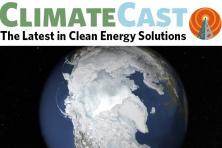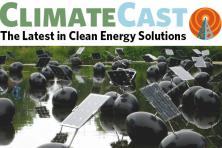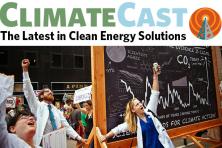Calls to action and innovative decisions to help save the climate
In case you needed another reason to love Hawaii, the state just adopted the most ambitious climate law in the country, mandating that the state become carbon neutral by 2045. Hawaii also passed a second law requiring the state to use carbon offsets to restore local forests, and a third one mandating that sea level rise be factored into the review process for building projects. In Washington State, voters may soon have the chance to enact their own historic climate law. A proposed pollution fee, Initiative 1631, or the Protect Washington Act, would put a $15 charge on each metric ton of carbon pollution emitted in Washington starting in 2020, with the price on emissions ramping up over time. Revenue generated from the fee would go toward investing in clean energy, protecting natural resources, and helping vulnerable communities become more resilient against climate impacts. On the federal level, a new bipartisan effort has emerged to prohibit offshore drilling, a proposal that should provide an opportunity for Republicans and Democrats to work together to protect our climate.
Divesting and investing to protect the climate
The Democratic National Committee recently voted to ban donations from fossil fuel companies—including contributions from corporate political action committees tied to the oil, gas, and coal industries. The American Medical Association passed a similar resolution, approving divestment from companies that get the majority of their incomes from fossil fuels. The AMA has also pledged to only do business with vendors that have environmental sustainability policies, and committed to help physicians and professional health organizations proceed with similar divestment efforts.
In climate-friendly investment news, billionaires are betting on energy storage. In 2016, some of the world’s wealthiest people jointly invested in a $1 billion fund to “support technologies capable of cutting global carbon emissions by at least 500 million metric tons annually.” Now, the first two start-ups the fund will invest in are both focused on energy storage -- an essential tool for helping extend the benefits of clean energy. Like fossil fuel divestment strategies, these investments show an economic as well as an environmental calculation that clean energy is the smart way forward. If economic considerations help us make sound climate policy decisions. that’s great; especially if, as new research suggests, current models may be seriously underestimating the true economic risk of climate change.
Solar development forecast: partly sunny
California has achieved a new milestone: In May, the state generated more power from solar than gas. Washington State is also looking to expand solar, with a proposal calling for utility-scale solar arrays on public rangeland from 40 to 2,400 acres. Grazing leases typically net the state less than $2 per acre per year, while Washington could earn $600-$1,000 per acre per year from solar.
In China, they’re taking solar to the streets. The country is testing out new roads paved with solar panels. Solar roads conserve land, a particularly important benefit in a heavily populated country like China. They are also less expensive to maintain; asphalt roads must be resurfaced often, whereas solar roads are more durable. But the forecast for solar is only partly sunny. President Trump’s tariff on imported solar panels has caused $2.5 billion in large solar installation projects to be cancelled or frozen, along with the jobs that go with them. A new industry report projects that the residential solar sector will remain flat through 2018 due to policy uncertainty.
Clean energy presses on
A new report reveals that a record amount of solar and wind capacity was installed throughout the world last year, and that clean power generation capacity had its largest annual increase ever in 2017. Even members of the Trump administration are starting to recognize the potential of clean energy. On a recent tour of coastal states, Interior Secretary Ryan Zinke found “magnitudes” more interest in offshore wind than oil and natural gas drilling. Based on findings from his recent tour, he is considering scaling back his previous plan to open federal waters for drilling. Meanwhile, Spain and Italy have joined a group of countries supporting a binding renewable energy target of 35%. ¡Viva España! Viva Italia!
Sea level rise may be worse than we thought (and that’s saying something)
Antarctica’s ice sheet is melting at a much faster rate than previously thought. Scientists have discovered that the rate of ice loss over the past five years has tripled compared to the previous two decades, meaning we can expect an additional six inches of sea level rise from Antarctica alone by 2100, on top of the two feet already projected. A separate study highlights how coral reefs offer a natural “buffer” to help reduce coastal-flood related damage, and save billions of dollars worldwide by preventing floods. An unprecedented conclusion from top scientists: We must either reverse U.S. climate policies and embrace the Paris Climate Accord quickly, or all of America’s coastal cities will be inundated in decades.
Off the scale, smashing records
May smashed temperature records across the US, and was on average 5.2 degrees above the 20th Century’s average for the month. Weather stations in the nation broke or tied nearly 8,600 daily heat records in May. In hurricane news, 2018 storms are projected to be so strong that “Category 5” may not be able to accurately classify them. Some climate scientists are advocating adding a Category 6 to help describe the extremely powerful super storms seen in recent years that are fueled by climate change. Hurricanes aside, coastal communities are already feeling the impact of climate change: the nation's coasts broke previous records for tidal flooding over the past year.
The Mauna Loa Observatory in Hawaii just recorded another climate milestone, and it’s not a good one. Carbon dioxide levels exceeded 411 parts per million in May, the highest monthly average ever recorded. A draft report from the UN claims we’re on course to exceed the most stringent goal set in the Paris agreement by around 2040. Using the EPA’s own numbers, two Harvard scientists have calculated that 80,000 more lives will be lost per decade if the EPA’s plans to roll back clean air and water protections are successful.
In brief: Algae blooms are becoming worse due to climate change
Salem, Oregon recently made headlines for two separate instances in which the city had to issue a drinking water advisory because an algae-produced toxin caused the water to be unsafe for vulnerable populations to drink. This situation has raised concerns about similar problems occurring elsewhere in the Northwest. Due to budget limitations, Oregon lakes are usually only tested if there’s a visible algal bloom, or if a city sets aside money to pay for testing. As climate change continues to impact algae levels in our water, how will we keep our water safe in a warming world?





